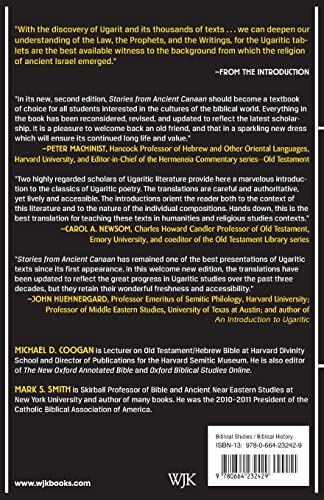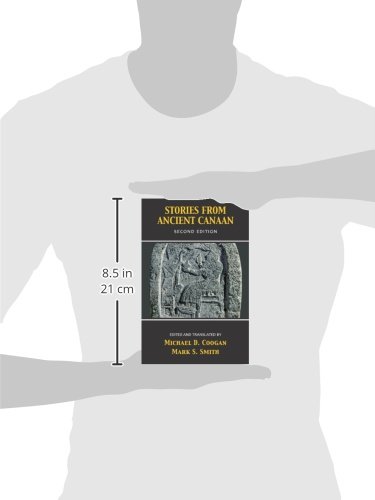معلومات عنا
دعم العملاء
احصل على التطبيق

قم بتوجيه الكاميرا لتنزيل التطبيق
حقوق الطبع والنشر © 2024 Desertcart Holdings Limited




Stories from Ancient Canaan, Second Edition
I**R
Ian Myles Slater on: Read This One First?
For I have a word to tell you, / a message to recount to you:the word of the tree and the whisper of the stone, / the murmur of the heavens to the earth, / of the seas to the stars.I understand the lightning that the heavens do not know, / the word that people do not know, / and earth's masses cannot understand.Come, I will reveal it: / in the midst of my mountain, divine Zaphon, / in the sanctuary, in the mountain of my inheritance, /in the pleasant place, in the hill of my victory. ("Baal," Tablet 3, col. 3, lines 21-31)In terms of the specific texts included in it, Michael D. Coogan's "Stories from Ancient Canaan," in its new, revised and expanded edition of 2012 (with Mark Smith) must be considered the "latest word" in translations from Ugaritic. This is the language written in an alphabetic cuneiform script, on tablets found at Ras Shamra on the Syrian coast, in a series of excavations starting in 1928, a site soon identified as ancient Ugarit (mentioned in Egyptian texts).The bulk of the contents, carried over from the first edition, concern battles for supremacy between gods, like those in Mesopotamian and Hittite myths, and, in Greek, in Hesiod's "Theogony," and encounters between gods and humans in "epic" settings reminding one of Homer. The 2012 edition also includes two additional, more purely mythological texts, "The Lovely Gods" and "El's Drinking Party."The co-translators were able to make use of the latest text editions (naturally including those by Smith himself) and the latest grammatical and lexical studies, and apparently did exactly that, so, for the moment, they are at the leading edge, at least in English. According to the "Advance Praise" endorsements (from an impressive set of scholars), the translation has been thoroughly revised; not having a copy of the first edition at hand, I have to take their word for it.Indeed, although the translators say "It is written for the reader without linguistic or scholarly background," readers who are familiar with more technical treatments might want to consider this one seriously, perhaps more so than the 1978 edition. Those who don't have the background -- like the undergraduates for whom the translation was originally intended -- will still find themselves in good hands.Since sometime in the late 1960s I've read half-a-dozen translations of the myths and epics discovered in the early excavations. Some covered the whole range of material, others were selective. Some emphasized the relation of the language and poetic style to those of the Hebrew Bible, some de-emphasized it. Some pointed out connections to other mythologies, some let the readers reach their own conclusions (if any).Along with the first edition of the present book, the list includes Cyrus H. Gordon's pioneering version, in two of its revisions; H.L. Ginsberg's 'Ugaritic Myths, Epics, and Legends' in Pritchard's "Ancient Near Eastern Texts Relating to the Old Testament" (1950 edition; pages 129-155); Theodor H. Gaster's wonderfully literate and richly annotated rendering of the Baal Cycle in "Thespis: Ritual, Myth and Drama in the Ancient Near East" (1950, revised 1966[?]); G.R. Driver's 1956 "Canaanite Myths and Legends" in the 'Old Testament Studies' series; the 1977 revision of Driver by J.C.L. Gibson; and, most recently, "Ugaritic Narrative Poetry," edited by Simon B. Parker, in the Society of Biblical Literature's 'Writings from the Ancient World' series (1997). [I have since reviewed this last; the two reviews should complement each other.]And my memory insists I've left one out, but doesn't extend to the translator's name.... Or maybe its a collective image of all the studies of the subject I've read. Anyway, I have a pretty fair background for a lay reader.I also can't recall whether Gordon's translation was the first I read, or H.L. Ginsberg's. Probably the latter, or the parts of it included in the paperback "Ancient Near East in Texts and Pictures," the abridged version of "Ancient Near Eastern Texts..." and "The Ancient Near East in Pictures," its companion volume. If Gordon's, it would have been in the 1965 edition of "The Common Background of Greek and Hebrew Civilization," not the later "Poetic Legends and Myths from Ugarit," published in the journal "Berytus" in 1977.)The one I later wished I had been able to read FIRST was Coogan's, which of course only appeared after I had read most of the others.Why first? To begin with, it read smoothly, and the pages were not, like Ginsberg's and many others, a confusing mass of empty brackets, italicized restorations, diacritical marks, and other signs of scholarly rigor in representing the state of the damaged tablets and knowledge of the language. I eventually got used to that, but at first it was an annoying hindrance.The new edition maintains this feature, useful in an introductory text, and when necessary briefly describes the problems rather than representing them typographically.Nor was the translation competing with Gaster's distractingly interesting commentary, not all of which, it seemed to me, actually illuminated the text, however much it had to do with Gaster's theories of ritual, myth, and performance, or how interesting it was to learn about various storm gods and their respective weapons.Coogan's work was not comprehensive for narrative texts, but it covered the three major works recovered early in the excavations, and one minor one: "Aqhat," the story of King Danel and his son and daughter; its possible sequel or companion, the fragmentary "Rephaim" text; "Kirta" (or Kret, or Keret; or, for the really cautious KRT), about a king who forgets to keep a vow, and the trouble that follows (most of the latter being missing); and "Baal" (or "Baal and Anat") about the storm-god Baal Hadad (and his sister Anat), and their battles with his enemies Sea and Death, as refereed by the High God El. (Or, depending on how the translator Biblicized, transliterated, or anglicized the names, Rapauma, Ba'lu, Haddu, Anath, Yamm, Mot, and Ilu.)Some of the confusingly (dis)ordered Baal Cycle (or "Baal and Anath") was not (and is not) included: but it seems to be a principle that every translator MUST find a new order for its tablets, or exclude something, or both. (Like the joking claim by some Germanists that there will be as many interpretations of any given runic inscription as there are runologists who have published concerning it.)The "Suggestions for Further Reading" seems to be up to date (for the moment, of course). I was surprised at first that it missed some titles (e.g., Gaster, and Driver/Gibson; but they are in a supplementary lists of critical translations and studies, a page or so farther in.I've been reading this edition in its Kindle edition, using the Macintosh Kindle app, and have been quite happy with the digital conversion. Despite a tendency for everything (not just headings) to appear in bold print, the smaller-print comments really do show up in smaller print (not always the case ) and are still legible (also not always the case). The hyperlinked Table of Contents provides more fine detail about the contents than the app's Content list, but the latter includes links to things like the cover and copyright page, which the ToC doesn't.Oh, there is one small coding problem; the app's Contents list shows "El's Drinking Party" as "El&x2019;s Drinking Party," which I can assure the reader is NOT a technical spelling of the god's name.[Additional Note, August 19, 2013; The Biblical Archeology Society (BAS) has announced the winners of its biennial Publications Awards for 2011-2012; "Stories from Ancient Canaan" was the winner in the category of "Best Popular Book on Archeology"]
S**I
Deepen your understanding of biblical story backdrops
Excellent source for anyone looking to deepen their understanding of biblical story backdrops & surrounding cultures.Though I am not fond of the "Ugarit and Ancient Israel" section in the Introduction, as I believe it is misleading based on the work of other academic scholars and should thus be labelled as the opinion of the editors and translators (Michael Coogan & Mark Smith), the material of the book is wonderful. The authors give detailed introductions to each narrative, and explain in detail where tablets are damaged, have missing parts, or are uncertain in meaning - hats off to Coogan & Smith for that!This material will be of use to anyone looking to understand the ancient religion of the ANE, as well as provide backdrop material for certain biblical passages & stories (such as the Rephaim - which seem to cause the most controversy IMO due to a lack of study on material such as what is presented in this book)This book also provides a glossary of characters/terms in the back, which is extremely helpful considering the number of unfamiliar characters/terms these tablets contain.
G**.
like me, interested in the mythic core of religions
If you are, like me, interested in the mythic core of religions, you will like this book. I bought it to explore similarities and differences between Hebrew myths and Canaanite myths, particularly to help me understand the differences between Yahweh and Elohim before they were conflated into Hebrew monotheism and how they are related to other Mediterranean and Middle-Eastern gods. This book will probably confirm your appreciation of the Canaanite myths as interesting and worthwhile in their own right. The editors also make some of the comparisons I was looking for, filling in the basic Ugaritic background and occasionally alluding to Egyptian, Akkadian, Babylonian, Greek, and Arabian myths and languages. It's hard, for me at least, to come away from the Ugarit material and not see Yahweh as a close counterpart to Baal, the storm god who dwells on the mountain. I'm still thinking about the Canaanite El's relationship to the Hebrew El/Elohim: the Canaanite myths of El and Baal suggest a generational distinction similar to Cronos and Zeus, that might apply to Elohim and Yahweh as separate gods. In any case, I recommend the book for readers seeking as direct an experience of these long-lost myths as the non-specialist can have. The only criticism I have of the book is that it doesn't define a term here and there that is unknown to the lay reader and yet important to the discussion, like "stela," which seems to be an upright slab of inscribed stone. We can only hope that, as more of the cuneiform tablets are discovered and transcribed, we will be able to read much more of the people of Ugarit and its milieu.
A**.
Five Stars
Fantastic book. Essential reading for anyone interested in biblical history and the ancient near east.
R**I
Excelente
O livro apresenta os principais textos religiosos encontrados na antiga cidade de Ugarit, que consistem em uma "janela" para um passado muito remoto e contemporâneo da vida dos Patriarcas Bíblicos do Antigo testamento. Cada narrativa contém uma introdução que a explica e a contextualiza, facilitando o entendimento dos textos. (Pode ser uma leitura difícil para quem não está familiarizado com o tema)
W**S
Great short read
Really simple to read. I appreciate the effort made to show the reader how damaged these stories are. This book really puts the bible into perspective and it amazes me the similarities and parallels that are in these two different yet similar texts.
N**S
Academically informative
Emminently academic. Bery well wrtten
ترست بايلوت
منذ شهر
منذ 3 أسابيع